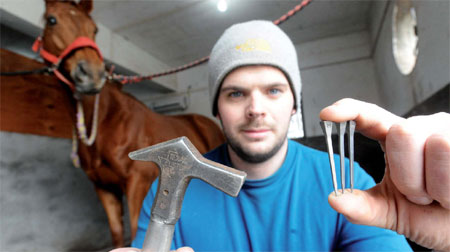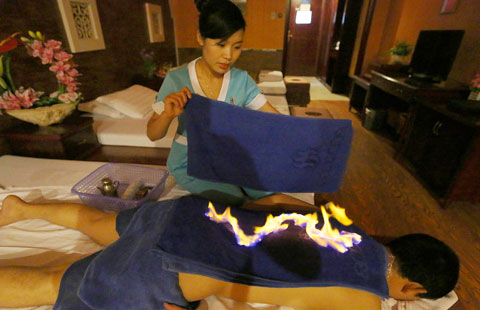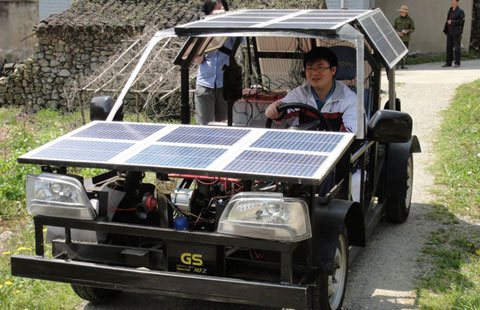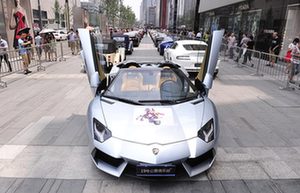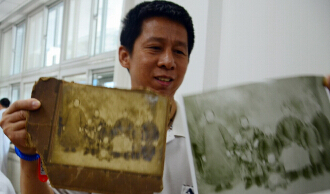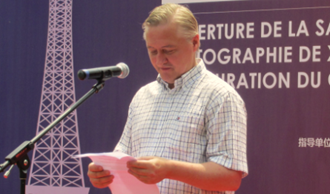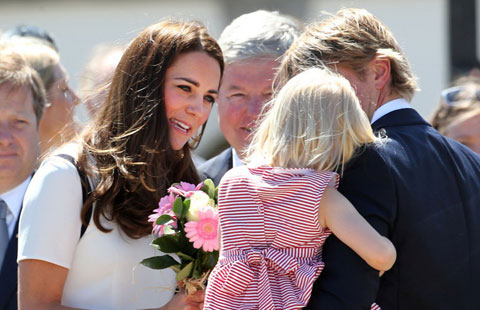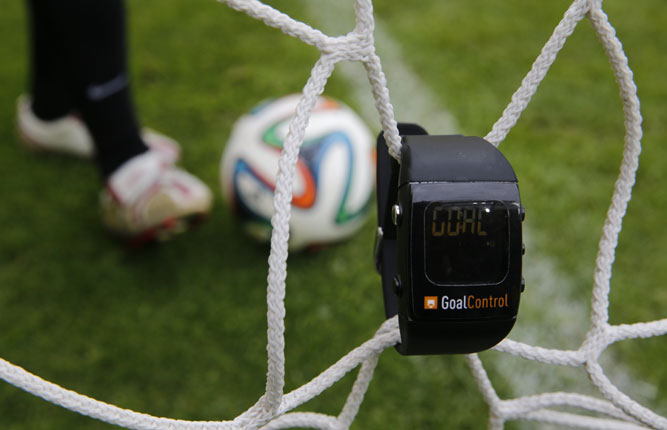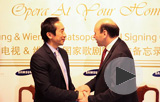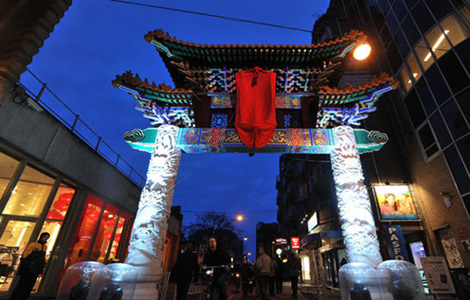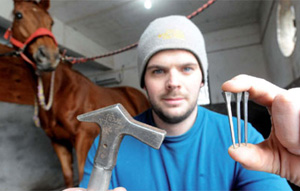Master of fancy foot work
By Luo Wangshu and Tan Yingzi ( China Daily Europe ) Updated: 2014-03-07 10:02:50
|
Arthur Judge has a busy life flying around the country to attend to his customers. Yang Xinyu / China Daily |
An Irish farrier is ensuring that horses in Chinese equestrian clubs put their best hoofs forward
It is a pleasure to watch a chestnut thoroughbred easily lifting its hoofs, walking freely, cantering, trotting, raising its forelegs and jumping over fixed obstacles.
When spectators applaud a grand performance by the rider and horse, they may forget to give credit to another important - person the farrier.
Arthur Judge is one of those workers behind the scenes. The 27-year-old Irishman shoes horses.
"I can make horses more comfortable by giving them appropriate shoes," he says.
Judge takes care of about 60 horses at the Phoenix Club in Chongqing, an exclusive equestrian club. He spends about 15 days a month in Chongqing, and on other days he flies around the country to care for horses in other cities, including Chengdu, Beijing and Guangzhou.
Judge has two work spaces in a stable in Chongqing. One is filled with his tools, including a toolbox stand, a blacksmith's work stand, a forge, a gas tank and a working table. The other stall, across the aisle, is empty. The latter one is for Judge's customers, horses.
Judge does not mind being confined in a room that is no more than 8 square meters.
"This is Ameng," Judge say introducing a thoroughbred from Britain.
"He is a good boy, a quiet one, always calm."
Judge shoes four horses a day on average and works four days a week. He charges 800 ($130; 95 euros) to 1,200 yuan to shoe one horse, depending on the hoof conditions.
"I can do it faster," he says. "But that will lower the quality."
He usually takes a horse to walk around before the shoeing, and they walk again after the work is done to see how the shoe fits.
"It is like when you are buying a pair of shoes, you have to try it on first," he says. Horses can bear much more pain than humans. It requires a farrier's experience to determine whether the shoes fit.
Judge lifts one of Ameng's hoofs, clamps it between his thighs, takes off the old shoe, cuts and polishes Ameng's nails, and then picks up a horseshoe that is the nearest size from his studio. He adjusts the shoe by firing and hammering it, puts it on the horse, takes it off to adjust, and finally positions it again and nails it in.
The whole process takes him about 15 minutes.
"The key is to choose the right size shoe and adjust it with my eyes," Judges says.
"I wear size 9, so I pick up size 9. But there is no standard size for horses' feet," says Judge, who stands 1.92 meters tall.
Deng Feifei, the sales director of the club, says Judge is the only master farrier in China.
"Only 144 farriers are certified master farriers in the world," Deng says.
Judge gained the status in 2010, becoming one of the youngest master farriers in the world. He was 23.
In Ireland, a farrier must pass a three-day exam to become a master farrier. The test includes shoeing five horses, completing a written test about shoeing and anatomy, and explaining horse dissection to experts.
"It was probably the most difficult three days in my life," Judge says.
Judge was born on a farm in Ireland and grew up among horses. His father breeds horses and owns about 120 to 130.
Judge can tell the name of "his" horses by looking at their faces, though he only sees them at four to five-week intervals, when the shoes need replacing.
He got his first taste of the occupation when he was 7, during a trip to England with a family friend, a farrier. He started to work with him during school holidays once he was 12.
In Britain and Ireland, farriers are required to have formal qualifications. Judge received his four-year college education at the Irish School of Farriery, one of the world's most respected schools in the field.
The curriculum includes shoeing practice, anatomy and dissection.
Having received a bachelor's degree in 2009, Judge worked globally to improve his skills, including in Britain and the US. He then passed the exam to become a master farrier.
Judge says his Chinese opportunity came by chance.
An equestrian club in Beijing called an Irish farrier federation in 2012 for help, asking for a farrier to shoe their competition horses. The federation turned to Judge, who said no at first.
"Why China? Chinese people don't care about horses," Judge recalls thinking, adding that he later took the one-month job because no one else was able to go.
He saw the worst hoofs he had ever seen on competition horses in Beijing, he says, adding that some were virtually lame. But he liked the opportunity to provide the remedy and to stay in China.
"You are never working with the perfect shoes. But my shoeing can help them. I can see my improvement by their feet getting better."
Qin Benchao, the chief veterinarian of the club, says Judge is an expert on hoofs.
Although working as a vet for 12 years, Qin says he has received plenty of useful advice from Judge on horses' feet.
"For example, we have a horse which suffered bad shoeing for years and walked with an awkward gait. I had nothing to do with it. But Judge made him special shoes, lifting the injured hoofs and allowing the injuries to heal," he says, adding that he speaks little English and Judge speaks no Chinese.
"We use sign language in daily communication and diagrams at work," Qin says.
In China, equestrian sports have become popular in recent years as people become more affluent and seek a sophisticated lifestyle.
However, there is no school or qualification for farriery work in China.
"If I can teach two, and they can teach another two, hopefully we can pass the professional standards to more in China," Judge says.
Contact the writers through luowangshu@chinadaily.com.cn
(China Daily European Weekly 03/07/2014 page28)
|
|
|
|
|
|
|
|
European Weekly
 We will not give up search, Li vows
We will not give up search, Li vows
International hunt for missing airliner continues after fruitless six-day search


